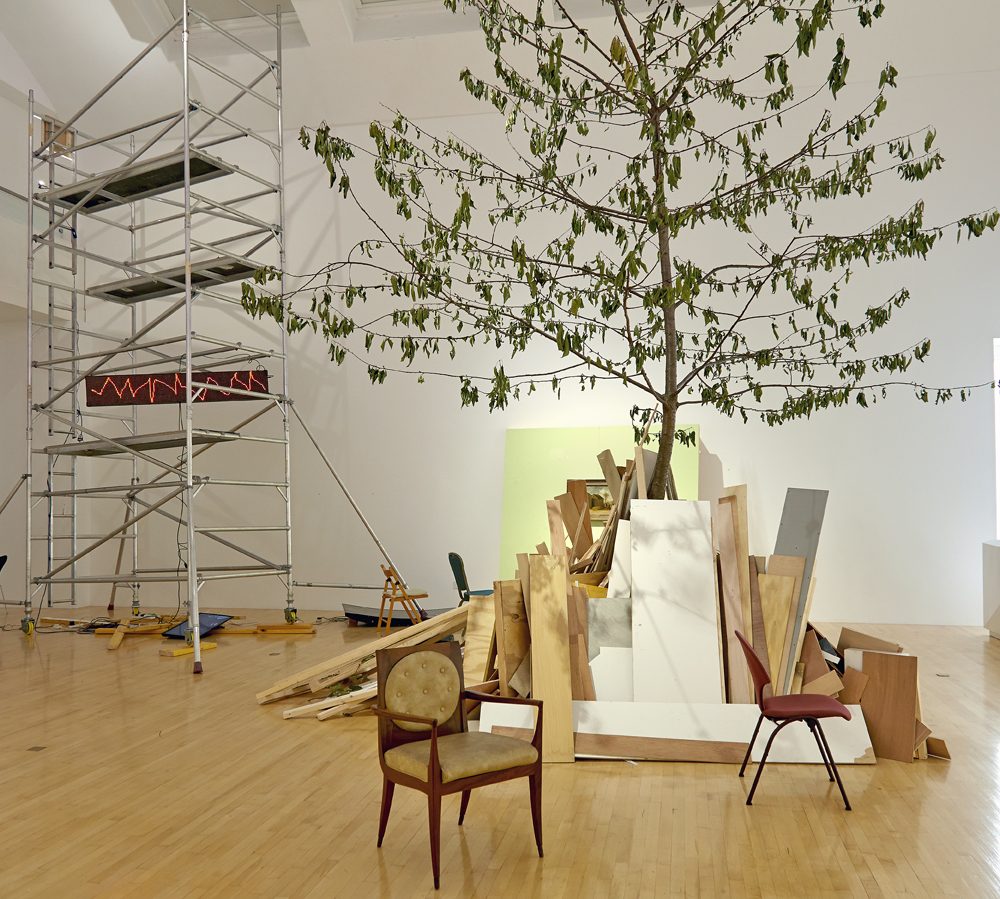Rob Kennedy, acts of dis play, Talbot Rice Gallery, Edinburgh, 29 October – 17 December 2016
Originally published at This is Tomorrow, 18 November 2o16, image courtesy of Talbot Rice Gallery
Glasgow-based artist Rob Kennedy’s new installation for Talbot Rice Gallery seeks to describe a gallery space as site for the jarring confluence of material, subjects, reference, interference and thought. His dizzying display captures together painting, spoken and written texts, found online video footage, animations, electronic music, live performance and sculptural installation. And among the wreckage of broken MDF walls, piles of cardboard boxes and haphazardly set scaffolding lie smashed LCD flat-screen television monitors attempting through their mortally wounded surfaces to continue to transmit an entropic video playback. A further layer of interference occupies the gallery as out-of-place voices read out a series of texts, announced and translated from the page by actors whose first language is not English. Occasionally a stroboscopic lamp will flicker out its quick visual rhythm in time to a series of LED message signs advertising pizzas, broken hearts and lines of texts from cultural or political summations. Meanwhile near-identical period paintings by David Teniers the Younger showing a farmyard scene from mid-eighteenth century France are installed on opposite collapsed ‘walls’ of the gallery. These walls, painted in pale yellow and green are made from the recycled wooden debris from a prior installation from another gallery exhibiting works in the city. The absence of a tree in one painting – in a game of spot the difference – is made physically abundant by a real tree culled from the local Botanical Gardens and installed centrally in the gallery. The image, like the tree, is no longer grounded.
A chorus of spoken references continues to peel out in the gallery. A voice says ‘video is pure movement, free of the inertia of film’ and ‘illusions are natural’. A second chant, voiced simultaneously by a male and female actor read out a series of cut-up thoughts on miscommunication, methods of distributing information and language’s tendency for unreliability and ambiguity: ‘doubt, signs, signage, signals, announcements, proclamations, mispronunciations, black is white, white is black.’ Later on as the credits roll in a large-screen video installed in the gallery’s mezzanine floor some of the texts are attributed to the experimental composer Michel Chion, novelist and essayist Don DeLillo, political theorist Hannah Arendt, and novelists John Galt and Louis-Ferdinand Céline. Kennedy brings to the space then a library of contextual readings that begin to recast his materials as performers and props in a highly-charged theatrical delivery of the gallery experience. His gallery is not a complacent container; Kennedy’s environments are energised, activated and live. And in this respect Kennedy’s practice makes clear reference to areas of experimental performance theatre or live art and their collision of opposing material or material comparison, or works where the tele-visual or technological forms an apparatus onto which other media information might rest, abscond into or become dislocated from, for example in the works of The Wooster Group from New York and there 1999 piece House/Light which mashes up the scripts from Gertrude Stein’s Dr Faustus Lights the Lights with Joseph Mawra’s 1960s b-move Olga’s House of Shame, or Forced Entertainment from Sheffield who in their performances ‘seek to make work for audiences who grew up with the television always on’. (Quoted by Lois Keidan in her 20th Birthday Letter to FE, http://www.forcedentertainment.com/notebook-entry/lois-keidan-20th-birthday-letter, 7 November 2016)
Here then the gallery is a workshop, unrestrained by conventional behaviours and allowed an opportunity for elaboration, magic and freedom. Ideas spill together and sources become unstable and out of place or time. Kennedy best expresses this through a series of YouTube videos inserted into his immaculately edited mezzanine-floor video: a white peacock in display in a suburban front yard; a lorry in China shunting off its cargo of bamboo scaffolding in a logical but nevertheless slapstick manner; a group of dogs responding individually to their names at feeding time; a riot played out by a group of identical half dressed men, and moments in video games where the code has gone awry and objects, characters or animals in the game play start to malfunction and the laws of physics become unpinned.
Signage becomes untrustworthy. The directions they point in are wrong. The messages they transmit are fractured and become unfamiliar. The voices on the video continue this refrain as film, video, sound and the image are discussed in terms of weight and mass as though sculptural; and materials and objects are discussed as disposable, marginal, flattened and weightless. Perceptions are inverted or reversed: ‘black is white, white is black’. A camera pan glides in slow motion over the landscape of a light bulb shot in high definition. A close inspection of its combinations of materials and technologies in the aid of illumination surges and suddenly bursts and the glowing filaments inside fade. Kennedy seeks to suggest the usability of these broken elements, and how they might be put to new uses and positions. Just as he suggests through this entanglement of media, readings, distractions and material new positions for us to look at the world and new positions from which a gallery might operate.
